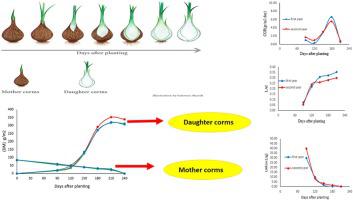Industrial Crops and Products ( IF 5.9 ) Pub Date : 2021-10-19 , DOI: 10.1016/j.indcrop.2021.114145 Fatemeh Moallem Banhangi 1 , Parviz Rezvani Moghaddam 2 , Ghorban Ali Asadi 2 , Soroor Khorramdel 2

|
Saffron, the primary in the market now, is a food spice by far the world’s most expensive. In order to study the effects of different corm seeding rates and sowing depth on physiological indices of saffron, an experiment was conducted as a factorial layout based on randomized complete block design with three replications at the research farm of the Ferdowsi University of Mashhad during 2015–2017 years. The experimental treatments were all combinations of different corms seeding rates in four levels (7, 8, 9, and 10 Mg ha−1) and sowing depth in three levels (10, 15, and 20 cm). The studied traits were the dry weight of mother and daughter corms, cumulative dry matter, and some growth indices such as leaf area index (LAI), crop growth rates (CGR), relative growth rate (RGR), and Leaf Area Ratio (LAR). The results showed 8 Mg ha−1 corm seeding rate and 10 cm sowing depth increased total crop dry weight, CGR, and RGR in saffron. Based on obtained results at the beginning of the vegetative growth period, CGR declined for a short time. So that by continuing the vegetative growth, the plant reached on growth compensation point, and then CGR increased. From 180 days after the sowing date and in the late stages of vegetative growth, the growth rates trend decreased again. The results also showed that the LAR trend decreased from the early vegetative growth period, which can be explained by the faster growth of the daughter corms and other underground parts of the plant than the leaves during the early vegetative growth period. According to the results and the natural trend of mother corm breakup during the growing season, increasing density due to increasing competition between mother corms caused intensification in a weight reduction of mother corms in the late stages of the growing season. Also, in the first three months after sowing, daughter corms did not grow anymore, and the beginning of their growth coincided with the end of the saffron flowering period.
中文翻译:

球茎播种率和种植深度会影响藏红花 (Crocus sativus L.) 的生长指标吗?
藏红花是目前市场上的主要香料,是迄今为止世界上最昂贵的食用香料。为了研究不同球茎播种量和播种深度对藏红花生理指标的影响,2015年在马什哈德费尔多西大学研究农场进行了一项基于随机完整区组设计的因子布局试验,重复3次- 2017 年。试验处理均为四个水平(7、8、9 和 10 Mg ha -1) 和三个级别(10、15 和 20 厘米)的播种深度。研究的性状是母子球茎干重、累积干物质和一些生长指标,如叶面积指数(LAI)、作物生长率(CGR)、相对生长率(RGR)和叶面积比(LAR)。 )。结果显示 8 Mg ha -1球茎播种率和 10 厘米播种深度增加了藏红花的总作物干重、CGR 和 RGR。从营养生长初期的结果来看,CGR 出现了短时间的下降。这样通过继续营养生长,植物达到生长补偿点,然后CGR增加。从播后180天到营养生长后期,生长速度再次呈下降趋势。结果还表明,LAR趋势从营养生长期早期开始下降,这可以解释为在营养生长期早期,子代球茎和植物其他地下部分的生长速度比叶片快。根据生长季节母球茎解体的结果和自然趋势,由于母球茎之间的竞争加剧,密度增加导致生长季节后期母球茎重量减轻的加剧。此外,在播种后的前三个月,子代球茎不再生长,它们的生长开始与藏红花开花期的结束相吻合。



























 京公网安备 11010802027423号
京公网安备 11010802027423号